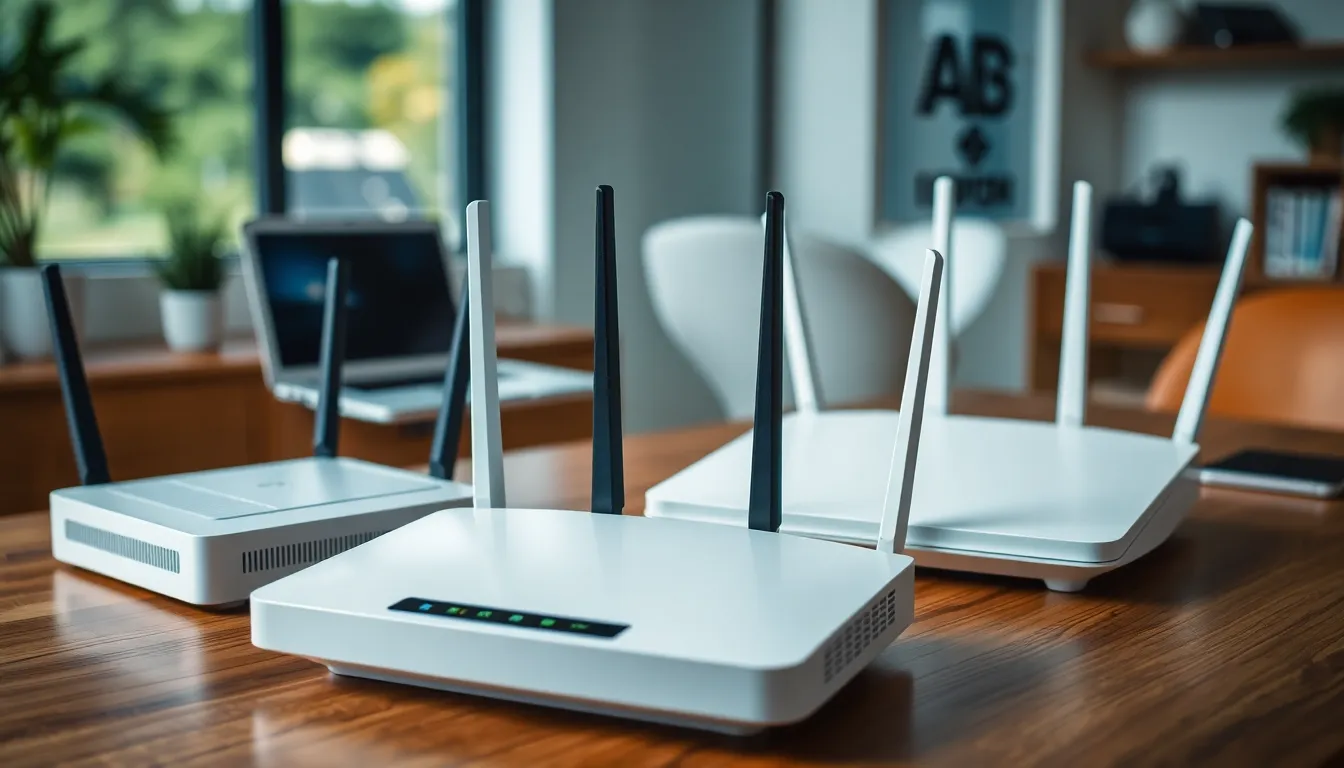In a world where buffering feels like a personal attack, WiFi is the unsung hero of modern life. It’s the invisible force that connects us to everything we love, from binge-watching cat videos to video calls with grandma. Without it, chaos would reign—who wants to go back to the days of dial-up? Not a chance!
But let’s face it: not all WiFi is created equal. Some connections are like a friendly neighbor who always borrows your lawnmower, while others are more like that one friend who shows up uninvited and eats all your snacks. Understanding WiFi can be the difference between seamless streaming and a night filled with frustration. Buckle up as we dive into the fascinating world of WiFi and discover how to optimize that sweet, sweet signal for a life less interrupted.
Table of Contents
ToggleOverview of WiFi Technology
WiFi enables wireless communication between devices, crucial for internet access. It uses radio waves to transmit data, connecting computers, smartphones, and other devices. Speeds vary based on WiFi standards, which include 802.11n, 802.11ac, and 802.11ax. Each standard improves speed and capacity, accommodating more users simultaneously.
The technology operates on different frequency bands, primarily 2.4 GHz and 5 GHz. The 2.4 GHz band offers longer range but has lower speeds. In contrast, the 5 GHz band provides faster speeds but with a shorter range. This allows for flexible usage based on specific needs.
Security within WiFi networks remains vital, with protocols like WPA2 and WPA3 safeguarding user data. Robust encryption protects against unauthorized access, ensuring safety during online activities. Network management tools allow users to monitor network performance and identify issues.
In urban environments, WiFi mesh systems enhance coverage by deploying multiple nodes. These systems eliminate dead zones, providing strong connections in larger homes or offices. Implementing these systems can significantly improve overall user experience.
Recent advancements also include WiFi 6 technology, which boosts efficiency and capacity. This new generation of WiFi handles numerous devices without performance drops. It prioritizes bandwidth for critical applications, ensuring smooth streaming and fast downloads.
WiFi’s significance in modern life continues to grow, facilitating everyday tasks and entertainment. Connectivity influences productivity, enabling remote work and seamless communication. Understanding the fundamentals of WiFi equips users to optimize their connections and improve their online experience.
Types of WiFi Standards

WiFi standards define how devices communicate over wireless networks. Each standard builds on the capabilities of its predecessors, enhancing performance and user experience.
802.11a/b/g/n/ac/ax
802.11a operates in the 5 GHz band, offering speeds up to 54 Mbps. 802.11b utilizes the 2.4 GHz band, providing a maximum speed of 11 Mbps. 802.11g combines both bands, capping at 54 Mbps. 802.11n introduces MIMO technology, allowing multiple spatial streams and boosting speeds up to 600 Mbps. 802.11ac further increases speed and capacity with advanced technologies, reaching up to 1.3 Gbps in optimal conditions. 802.11ax, known as WiFi 6, enhances efficiency in dense environments, supporting speeds up to 9.6 Gbps across numerous devices.
Differences Between Standards
Differences become apparent in range, speed, and frequency usage among standards. 802.11a and 802.11ac excel in speed and capacity but utilize shorter ranges due to 5 GHz frequency. In contrast, 802.11b and 802.11g operate in the 2.4 GHz band, offering wider coverage but lower speeds. 802.11n strikes a balance with wider range and improved speeds through multiple antennas. 802.11ax outperforms all in dense settings, allowing efficient data transmission to various devices simultaneously. Understanding these distinctions helps users select the most suitable standard for their connectivity needs.
Advantages of WiFi
WiFi offers numerous advantages that enhance user experiences in various ways.
Convenience and Mobility
Users enjoy the freedom of connecting multiple devices without the constraints of wires. Flexibility in movement allows individuals to access the internet from different locations within a coverage area. Laptops, smartphones, and tablets effortlessly connect, enabling browsing or streaming from any room. Instant access simplifies tasks like video calls and online shopping, promoting productivity in both home and work settings. Remote work benefits immensely; employees can set up their workspace wherever they feel comfortable. Enhanced accessibility supports social interactions and entertainment, making WiFi a crucial component of modern lifestyles.
Cost-Effectiveness
Cost savings emerge as a significant advantage of WiFi technology. Establishing a wireless network typically reduces the need for extensive cabling and infrastructure, minimizing installation costs. Monthly service charges for internet access remain affordable, especially compared to traditional wired solutions. Shared networks enable multiple users to connect simultaneously, distributing costs among family members or colleagues. In many cases, free public WiFi hotspots provide access without incurring additional expenses. Overall, WiFi presents a budget-friendly option for reliable internet connectivity, making it attractive for households and businesses alike.
Challenges of WiFi
WiFi faces several challenges that affect connectivity and user experience.
Security Concerns
Security is paramount in WiFi networks. Unauthorized access can lead to data breaches, making users vulnerable to cyberattacks. Protocols like WPA2 and WPA3 provide essential protection through encryption. Risks increase with open networks commonly found in public spaces. Users connecting to free hotspots should avoid sensitive transactions to mitigate exposure. Implementing strong passwords and regularly updating firmware enhances security as well. Understanding the importance of network security helps users protect their personal information effectively.
Signal Interference
Signal interference significantly impacts WiFi performance. Obstacles such as walls and furniture weaken signals, particularly at 5 GHz frequencies. Additionally, devices like microwaves and cordless phones can disrupt connectivity. Overlapping channels also create interference, especially in densely populated areas. Identifying and changing channels on routers alleviates some issues. WiFi mesh systems help extend coverage in larger spaces, minimizing dead zones. Optimizing placement of routers ensures stronger signals reach all devices. Addressing these factors helps maintain a stable and reliable WiFi connection.
Future of WiFi Technology
Emerging WiFi technologies promise to revolutionize connectivity. WiFi 6E introduces access to the 6 GHz band, augmenting bandwidth and minimizing interference for enhanced user experience. Capable of supporting more devices simultaneously, this technology elevates performance in crowded environments.
The advent of WiFi 7, anticipated for release in 2024, emphasizes faster speeds and reduced latency. Expected speeds might reach up to 30 Gbps, empowering applications demanding high data transfer rates, such as virtual reality and 8K streaming. Multiple-channel utilization allows efficient data transmission, ensuring a smoother online experience.
Integration of artificial intelligence into WiFi management systems optimizes connection quality. AI-driven tools automatically adjust parameters based on network traffic and specific user demands. Such innovations not only enhance performance but also simplify troubleshooting and network maintenance.
Security enhancements continue to evolve alongside WiFi advancements. New protocols provide robust encryption methods, safeguarding users against cyber threats in an increasingly connected world. Education on security practices becomes paramount as reliance on WiFi grows.
Mesh technology is gaining momentum as a solution for extensive coverage in large spaces. By employing multiple interconnected nodes, users experience seamless connectivity throughout their homes or offices. This setup eliminates the frustration of dead zones, allowing for uninterrupted access.
The expansion of WiFi-enabled devices fuels the demand for greater capacity and efficiency. Smart home gadgets, wearables, and IoT devices contribute to network congestion, necessitating further advancements. Upcoming technologies aim to accommodate this increasing demand for connectivity across various applications.
The future of WiFi technology reflects a commitment to improving user experience while addressing connectivity challenges. Continuous innovation ensures that WiFi remains a cornerstone of modern communication, shaping how people interact and work in the digital age.
WiFi continues to be an essential part of everyday life as it shapes how people connect and interact. With ongoing advancements in technology and security, users can expect faster speeds and improved performance. The emergence of WiFi 6 and future developments like WiFi 7 promise to enhance connectivity even further.
As reliance on WiFi grows, understanding its nuances becomes increasingly important. By optimizing networks and implementing robust security measures, individuals and businesses can enjoy seamless and secure online experiences. The future of WiFi is bright and full of potential, ensuring it remains a vital resource in the digital landscape.



